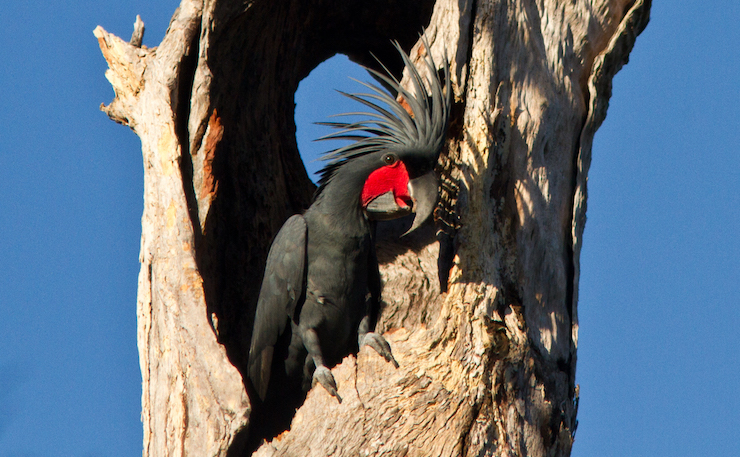A flaw in environmental law prevents regulators seeing the forest from the (rapidly disappearing) trees. That’s why this species is fighting for survival, writes Andrew Picone.
Australia’s largest cockatoo, the palm cockatoo (Probosciger aterrimus macgillivrayi) is headed towards extinction as a spate of new strip-mining projects are set to obliterate substantial tracts of habitat on Cape York Peninsula.
Listed as vulnerable under the Commonwealth’s Environment Protection and Biodiversity Conservation (EPBC) Act in October 2015, the plight of the palm cockatoo is symptomatic of Australia’s inadequate environmental laws.
Bauxite mining operations on Cape York’s west coast have already reduced nesting hollows and feeding habitat for the cockatoo over the last 40 years. Further, with about 85 per cent of a unique type of tall open forest that provides important habitat for the palm cockatoo covered either by mining leases or exploration permits, the loss of habitat will be ongoing.
For example, Rio Tinto has about 386,000 hectares of mining lease on Cape York associated with their Weipa operations and new Amrun project. The mining footprint for the Amrun project is a massive 30,000 hectares.
As the price of bauxite slowly climbs with increased demand from China, a variety of proponents are lining up for Commonwealth approval. While these projects will bring employment and economic benefits to the region, it will come at a heavy cost to the environment.
Massive swathes of habitat will be cleared over the coming decades. The very nature of bauxite mining precludes the possibility of rehabilitation to pre-mining forest diversity. Further, neither the Queensland nor Commonwealth governments are considering the combined impact of multiple mining operations in this unique region.
According to advice from the Commonwealth’s Threatened Species Scientific Committee, the palm cockatoo faces extinction through the loss of suitable nesting hollows arising from the cumulative impact of fire, cyclones, and mining. In addition, Queensland’s weakened vegetation laws now leave its habitat vulnerable to clearing for agriculture.
A key flaw in the approvals process under current national environment laws is the unwillingness to consider the cumulative impact of a number of individual projects on a population of threatened species across a geographic area.
Professor Rod Heinsohn from ANU’s Fenner School of Environment and Society is currently leading research into the population dynamics of palm cockatoos throughout Cape York. Based on new and ongoing research into population interactions across the Cape’s sub-regions, he believes the threats are understated.
Without robust bioregional planning, the identification and protection of critical habitat, and more effective environmental laws, the cumulative impacts are likely to cause a significant decline in palm cockatoo numbers. We risk destroying what ecologists call source populations. Once gone, recovery of any species is challenging, costly, and never guaranteed.
If we continue to assess each mining proposal in a piecemeal way, we will be blind to the long-term impacts of incremental habitat loss from multiple projects. This is illustrated by various environmental reports associated with different mining projects, each acknowledging a confirmed impact on the palm cockatoo, but each claiming that it will not be significant.
While land use conflicts have plagued Cape York for decades, the impending expansion of bauxite mining requires a coordinated approach. Central to that approach is the need to identify critical habitat for threatened species, consider the potential cumulative impact of multiple projects over a period of time, and respond with evidence-based conservation measures.
Unfortunately, we are likely to expedite the Palm Cockatoo, and many other species, towards extinction without urgent reform of our national environment laws. A business-as-usual approach will only result in depriving future generations of their ecological and cultural inheritance.
As it stands now, the Turnbull government has no interest in strengthening environmental laws. In fact, they want to divest responsibility for nationally significant issues to state governments while making approvals easier. As we saw in Queensland under the Abbott and Newman governments, approvals for land-clearing soared without any federal oversight.
Labor has pledged to explore options to set up a federal environmental oversight body and reverse the current government’s attempts to transfer national approval powers to the states. But stronger protections are still required for threatened species.
In an ambitious proposal, the Greens recently announced their commitment to a new generation of laws. Laws that would separate science from politics, strengthen protections and increase the independence of decision making.
Saving the palm cockatoo from extinction, along with the other 1,794 nationally threatened species, will require better laws, more independent research and government commitment.
Donate To New Matilda
New Matilda is a small, independent media outlet. We survive through reader contributions, and never losing a lawsuit. If you got something from this article, giving something back helps us to continue speaking truth to power. Every little bit counts.





